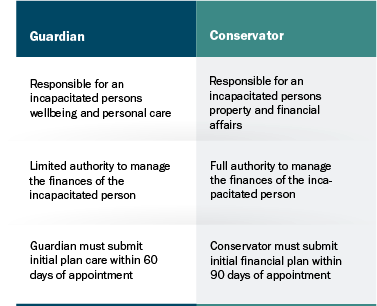Conservatorship vs Guardianship
Definition of conservatorship
A conservatorship is a legal concept in which the court appoints a responsible person or organization (called the “conservator”) to care for another adult (called the “conservatee”) who cannot care for themselves or manage their own finances.
Definition of guardianship
A guardianship is when the court appoints a guardian to care for a minor child or for an adult with disabilities who cannot make appropriate decisions for themselves.
Types of conservatorships
There are two main types:
- Person/care conservatorship: The conservator is responsible for the conservatee’s care and well-being. This may include decisions about medical care, housing, and other personal matters.
- Estate conservatorship: The conservator manages the conservatee’s finances and assets. They must handle matters like paying bills, making investments, etc.
Many conservatorships involve both personal care and financial management (a “general” conservatorship).
Types of guardianships
The two main categories are:
- Guardian of the person: This gives custody over the ward and the power to make decisions about their support, care, health, education, and welfare.
- Guardian of the estate: This involves authority over the ward’s assets, income, trust funds, insurance policies, and more. Their finances are handled by the guardian.
Some guardians are appointed to both roles.
Key differences
While conservatorships and guardianships have some similarities, there are important distinctions:
Control over person
In a guardianship, the guardian has custody and control over the daily life and decisions of their ward. With a conservatorship, the competent adult retains their rights – a conservator cannot forcibly control the conservatee.
Control over finances
Like guardians, conservators are given legal authority to make decisions about the conserved person’s financial matters and assets.
Duration
Temporary vs permanent
Guardianships typically last until the child becomes an adult or the disabled person no longer requires a substitute decision-maker. Conservatorships can be temporary but are often indefinite if the person’s inability to manage their affairs is unlikely to improve.
Who initiates
While both go through the courts, conservatorships are usually initiated by a family member or close friend rather than a state agency. Guardianships often involve child protective services or adult protective services.
Court supervision
Conservatorships generally require more ongoing court supervision, accountings, and specific court permission for major transactions or asset transfers. Guardians have more flexibility but must still act in the ward’s best interests.
When conservatorship is appropriate
Key times when a conservatorship makes sense:
- The person has assets that need active management and protection; they can’t do this responsibly themselves.
- Health issues like dementia, brain injuries, or severe mental illness leave them unable to handle their own care and medical decisions.
- They can communicate their basic needs but can no longer make major life decisions.
- Less restrictive options have been explored but determined insufficient to meet their needs.
When guardianship is appropriate
Minors
If a child has no parents able to care for them, a guardian steps in to provide custody, care, and decision-making until adulthood.
Disabled adults
For those with severe disabilities present since early life, guardianship ensures someone advocates for their needs if they can’t effectively communicate them themselves.
Seniors
Elderly individuals with dementia, Alzheimer’s disease, or similar conditions may require a guardian to manage their daily affairs and provide supervision for their safety.
The conservatorship and guardianship process
The process to establish a conservatorship or guardianship is very thorough to ensure the rights of all parties are protected. Key steps include:
Petitioning the court
An interested party files a formal petition requesting conservatorship/guardianship and alleging reasons why the individual cannot responsibly manage their welfare and/or estate.
Investigations
Courts appoint investigators in both kinds of cases. They may require medical evaluations of the capacity and competency of the proposed conservatee or ward.
Hearings
The court holds a formal hearing in which interested parties can argue for or against the conservatorship/guardianship before a final ruling.
Ongoing responsibilities
If appointed, the conservator/guardian takes on a fiduciary duty and legal obligations to the protected person. These include:
Accountings
They must provide detailed, regular reports to the court about the person’s finances and how their assets are being handled.
Status reports
These report on living arrangements, medical care, and personal welfare of the conservatee/ward to ensure their needs are being appropriately met.
Alternatives to consider
Before pursuing conservatorship or guardianship, always explore less restrictive decision-making options:
Supported decision making
Advisors, family, and professionals work with the individual to understand scenarios, weigh options, and communicate decisions they can make for themselves.
Powers of attorney
These legal documents authorize an agent to handle finances or medical decisions on someone else’s behalf if they become incapacitated in the future.
Health care proxies
An appointed health care proxy can make medical decisions guided by the wishes and values of the incapacitated person.
Living trusts
Transferring assets to a living trust sidesteps the need for conservatorship since a trustee manages those assets for the trust creator’s benefit.
Representative payees
Government agencies like Social Security can appoint representative payees to handle benefits/entitlement disbursements for those unable to manage the money themselves.
Summary and conclusions
Key takeaways
- Conservatorships apply to adults while guardianships cover minors and certain incapacitated adults.
- Less restrictive decision-making options should be weighed first before pursuing legal appointment of a conservator or guardian.
- Both come with court supervision and entail serious responsibilities for those acting on behalf of the protected individuals.
Questions to ask
If considering guardianship or conservatorship, be sure to ask:
- What options less restrictive than court-appointed oversight might meet this person’s needs?
- If their condition might improve over time, could a temporary/limited guardianship or conservatorship allow more self-determination later?
- What aspects of decision-making seem most impacted right now, personal welfare or financial/asset management? Can we narrowly address those deficits first?
- Who would be in the best position to advocate for this person’s wants and serve their wellbeing if the court appoints a conservator/guardian?
FAQs
What are alternatives to conservatorship and guardianship? Alternatives like supported decision-making agreements, powers of attorney, health care proxies, trusts, or representative payees may meet an individual’s needs with less court intervention.
Who pays when a conservator or guardian is appointed? Payment arrangements vary by state law – sometimes the assets of the protected person cover costs, other times conservators/guardians serve voluntarily or receive government stipends.
Can a conservatorship/guardianship be terminated? Yes, the courts will dissolve them when the protected individual regains competence or capacity, or if less restrictive alternatives can meet their needs.
How do I petition for conservatorship/guardianship? There are court petition forms allowing someone to formally request legal authority over a person who cannot make responsible decisions for themselves.
What happens if a guardian or conservator abuses their power? Courts require regular accountings and status reports to prevent exploitation. If abuse occurs, the judge can impose sanctions or terminate/replace the derelict conservator/guardian.






